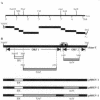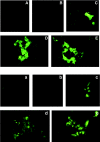Capped RNA transcripts of full-length cDNA clones of swine hepatitis E virus are replication competent when transfected into Huh7 cells and infectious when intrahepatically inoculated into pigs
- PMID: 15650181
- PMCID: PMC544089
- DOI: 10.1128/JVI.79.3.1552-1558.2005
Capped RNA transcripts of full-length cDNA clones of swine hepatitis E virus are replication competent when transfected into Huh7 cells and infectious when intrahepatically inoculated into pigs
Abstract
Swine hepatitis E virus (swine HEV), the first animal strain of HEV to be isolated, is a zoonotic agent. We report here the construction and in vitro and in vivo characterizations of infectious cDNA clones of swine HEV. Eight overlapping fragments spanning the entire genome were amplified by reverse transcription-PCR and assembled into a full-length cDNA clone, clone C, which contained 14 mutations compared to the consensus sequence of swine HEV. RNA transcripts from clone C were not infectious, as determined by intrahepatic inoculation into pigs and by in vitro transfection of Huh7 cells. Multiple site-based site-directed mutagenesis was performed to generate three new cDNA clones (pSHEV-1, pSHEV-2, and pSHEV-3) which differed from each other. The transfection of capped RNA transcripts into human liver Huh7 cells resulted in the synthesis of both ORF2 capsid and ORF3 proteins, indicating that the cDNA clones were replication competent. Each of the three clones resulted in active swine HEV infections after the intrahepatic inoculation of pigs with capped RNA transcripts. The patterns of seroconversion, viremia, and fecal virus shedding for pigs inoculated with RNA transcripts from clones pSHEV-2 and pSHEV-3 were similar to each other and to those for pigs inoculated with wild-type swine HEV, suggesting that the nucleotide differences between these two cDNA clones were not critical for replication. Pigs inoculated with RNA transcripts from clone pSHEV-1, which contained three nonsilent mutations in the ORF2 capsid gene, had a delayed appearance of seroconversion and fecal virus shedding and had undetectable viremia. The availability of these infectious cDNA clones affords us an opportunity to understand the mechanisms of cross-species infection by constructing chimeric human and swine HEVs.
Figures



Similar articles
-
Construction and characterization of infectious cDNA clones of a chicken strain of hepatitis E virus (HEV), avian HEV.J Gen Virol. 2005 Sep;86(Pt 9):2585-2593. doi: 10.1099/vir.0.81070-0. J Gen Virol. 2005. PMID: 16099918
-
Rescue of a genotype 4 human hepatitis E virus from cloned cDNA and characterization of intergenotypic chimeric viruses in cultured human liver cells and in pigs.J Gen Virol. 2012 Oct;93(Pt 10):2183-2194. doi: 10.1099/vir.0.043711-0. Epub 2012 Jul 25. J Gen Virol. 2012. PMID: 22837416 Free PMC article.
-
Construction of an infectious cDNA clone of a swine genotype 3 HEV strain isolated in Shanghai, China.Intervirology. 2014;57(2):74-82. doi: 10.1159/000357192. Epub 2014 Jan 25. Intervirology. 2014. PMID: 24480875
-
Culture systems for hepatitis E virus.J Gastroenterol. 2013 Feb;48(2):147-58. doi: 10.1007/s00535-012-0682-0. Epub 2012 Oct 27. J Gastroenterol. 2013. PMID: 23104469 Free PMC article. Review.
-
Reverse genetics approaches for hepatitis E virus and related viruses.Curr Opin Virol. 2020 Oct;44:121-128. doi: 10.1016/j.coviro.2020.07.004. Epub 2020 Aug 17. Curr Opin Virol. 2020. PMID: 32818718 Review.
Cited by
-
Mutational analysis of the hypervariable region of hepatitis e virus reveals its involvement in the efficiency of viral RNA replication.J Virol. 2011 Oct;85(19):10031-40. doi: 10.1128/JVI.00763-11. Epub 2011 Jul 20. J Virol. 2011. PMID: 21775444 Free PMC article.
-
Identification of functional cis-acting RNA elements in the hepatitis E virus genome required for viral replication.PLoS Pathog. 2020 May 20;16(5):e1008488. doi: 10.1371/journal.ppat.1008488. eCollection 2020 May. PLoS Pathog. 2020. PMID: 32433693 Free PMC article.
-
Extended Microbiological Characterization of Göttingen Minipigs in the Context of Xenotransplantation: Detection and Vertical Transmission of Hepatitis E Virus.PLoS One. 2015 Oct 14;10(10):e0139893. doi: 10.1371/journal.pone.0139893. eCollection 2015. PLoS One. 2015. PMID: 26466154 Free PMC article.
-
A Nanoparticle-Based Trivalent Vaccine Targeting the Glycan Binding VP8* Domains of Rotaviruses.Viruses. 2021 Jan 6;13(1):72. doi: 10.3390/v13010072. Viruses. 2021. PMID: 33419150 Free PMC article.
-
Molecular biology and replication of hepatitis E virus.Emerg Microbes Infect. 2012 Aug;1(8):e17. doi: 10.1038/emi.2012.7. Epub 2012 Aug 22. Emerg Microbes Infect. 2012. PMID: 26038426 Free PMC article. Review.
References
-
- Arankalle, V. A., M. V. Joshi, A. M. Kulkarni, S. S. Gandhe, L. P. Chobe, S. S. Rautmare, A. C. Mishra, and V. S. Padbidri. 2001. Prevalence of anti-hepatitis E virus antibodies in different Indian animal species. J. Viral Hepat. 8:223-227. - PubMed
-
- Boyer, J. C., and A. L. Haenni. 1994. Infectious transcripts and cDNA clones of RNA viruses. Virology 198:415-426. - PubMed
-
- Drobeniuc, J., M. O. Favorov, C. N. Shapiro, B. P. Bell, E. E. Mast, A. Dadu, D. Culver, P. Iarovoi, B. H. Robertson, and H. S. Margolis. 2001. Hepatitis E virus antibody prevalence among persons who work with swine. J. Infect. Dis. 184:1594-1597. - PubMed
-
- Emerson, S. U., and R. H. Purcell. 2003. Hepatitis E virus. Rev. Med. Virol. 13:145-154. - PubMed
Publication types
MeSH terms
Substances
Associated data
- Actions
- Actions
- Actions
Grants and funding
LinkOut - more resources
Full Text Sources
Other Literature Sources

